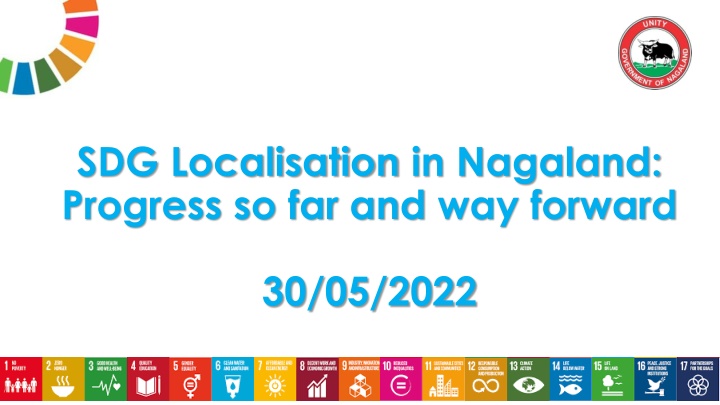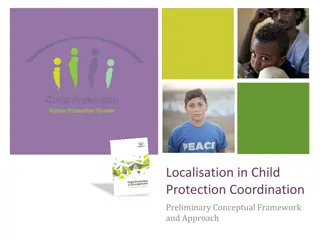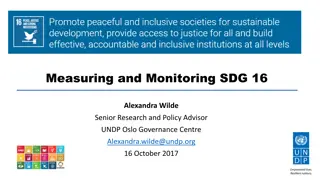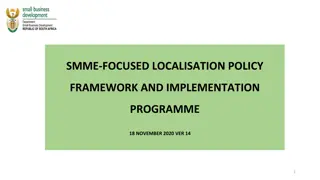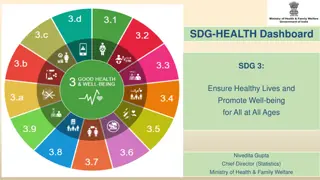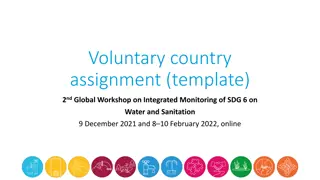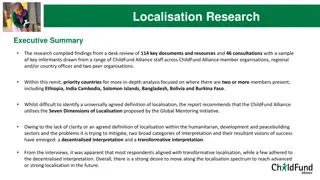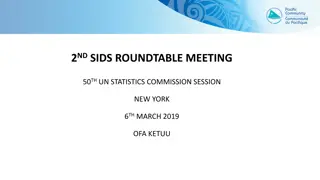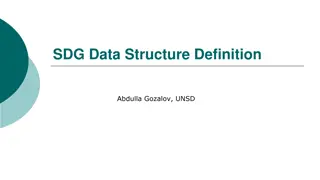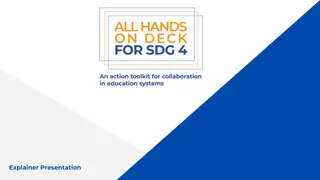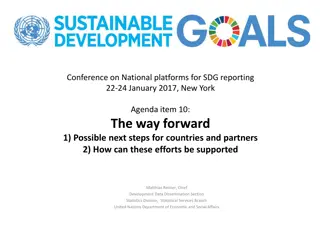Progress of SDG Localisation in Nagaland: Achievements and Future Directions
Nagaland has made significant progress in localising the Sustainable Development Goals (SDGs) with the establishment of the SDG Coordination Centre and the release of the SDG 2030 Vision Plan. Institutional mechanisms, capacity building workshops, and indicator frameworks have been put in place to drive the implementation of SDGs. The mapping of government schemes to SDG indicators, development of the SDG dashboard, and focus on monitoring and evaluation reflect Nagaland's commitment to inclusive development. Challenges remain, but the state is moving forward with dedication and strategic planning.
Download Presentation

Please find below an Image/Link to download the presentation.
The content on the website is provided AS IS for your information and personal use only. It may not be sold, licensed, or shared on other websites without obtaining consent from the author.If you encounter any issues during the download, it is possible that the publisher has removed the file from their server.
You are allowed to download the files provided on this website for personal or commercial use, subject to the condition that they are used lawfully. All files are the property of their respective owners.
The content on the website is provided AS IS for your information and personal use only. It may not be sold, licensed, or shared on other websites without obtaining consent from the author.
E N D
Presentation Transcript
SDG Localisation in Nagaland: Progress so far and way forward 30/05/2022
Contents 1. Institutional mechanism for implementation of SDGs 2. Progress so far of SDG localisation 3. SDG monitoring mechanism and dashboard 4. Way Forward 5. Best Practices 6. Challenges
1. Institutional mechanism With technical support from United Nations Development Programme (UNDP), the SDG Coordination Centre (SDGCC) in the Planning & Coordination Department was established in September 2019 with a mandate to act as a dedicated centre for SDG knowledge dissemination, monitoring, policy strengthening, and as an accelerator of SDG implementation across the state. Consituted High-Level Steering Committee headed by Chief Secretary on October 16, 2019 for guidance, monitoring, policy review and course corrections. Departmental SDG Cells in all relevant departments have been created with Nodal officers. District SDG Committee constituted at all Districts under the chairmanship of Deputy Commissioner.
2. Progress so far (1/3) Released SDG 2030 Vision Plan for Nagaland SDG 2030 Vision Plan outlines current interventions, challenges associated with ongoing programmes,proposed strategies to achieve the SDG Vision 2030 and priority indicators with target values. It has been prepared through a participatory approach to create a holistic pathway for inclusive development of Nagaland Capacity building for taking forward, localising the SDGs and quality data updation: State-level capacity building workshops and consultations held District-level workshops held in 2020 and 2021 across all 12 districts of Nagaland State and District Indicator Framework Finalized the State and District Indicator Framework aligned to National Indicator Framework after extensive consultations with the concerned departments
2. Progress so far (2/3) Progress so far (2/3) Mapping of all ongoing Central Government and State Government schemes with the relevant SDG indicators has been completed Released SDGDistrict Manual for SDG localisation and integration Published brochure contextualising the SDGs in North East India Monitoring and Evaluation Identified focus indicators and focus districts based on State performance in the SDG India Index and NER District SDG Index for focused interventions and frequent review by Depts/Districts SDG Dashboard for Nagaland being developed as a single platform for SDG data collection, monitoring and analysis
3. Progress so far (3/3) Progress so far (2/3) Strengthening SDG outreach and dissemination Developed publicity material, an SDG Promotional Video and radio jingle for localizing SDGs across the state which was widely disseminated through all media and social media platforms Released first and the second editions of SDG Newsletter aligned to COVID-19 responses SDG one stop destination counter at the Hornbill Festival 2021 for dissemination on the SDG agenda which received wide appreciation Organised a Green Christmas campaign for greater awareness and encourage on-ground action towards localisation of the SDGs Implementing three innovative projects as part of SDG Innovation Participatory Action Research Initiative for fast-tracking the priority SDGs SDG dissemination through online quiz and All India Radio Kohima
. 3. Progress so far (4/4) Progress so far (2/3) Trainings conducted on LSDG s SIRD, Nagaland had conducted a Pilot Training on LSDGs in Kohima District Training on Localization of Sustainable Development Goals through Village Functionaries Sl.No. Training date RD Blocks Venue Level of Participants VCCs & VDB Secretaries VCCs & VDB Secretaries Resource Person 1 23-24 May 2022 25-26 May 2022 Chiephobozou & Botsa Kohima, Jakhama & Sechu BDO Conference Hall, Chiephobozou Red Cross Conference Hall, Kohima Dr.Kedise Pucho, Principal, ETC Phek, SIRD. 2
4. Monitoring mechanism and dashboard The SDG Dashboard specific to Nagaland indicators is in process. This dashboard will help in the regular availability of quality and accurate data, real-time monitoring, analyzing and streamline the process of implementation of the SDGs. A single point source for SDG data at State and District level with provisions forProgrammes & Schemes, Baseline, Targets, Action Plans, Ranking, Financial Allocation & Expenditure
5. Way forward (1/2) Timelines for localization of SDGs training 2022 Sl.N o. Date Meeting Level of Participation Resource Person Agenda SI SIRD Nagaland Action Plan on localization of SDGs 2022 RD Nagaland Action Plan on loc SIRD Nagaland Action Plan on localization of SDGs 2022: SI SIRD Nagaland Action Plan on localization of SDGs 2022 alization of SDGs 2022 June 2022 (3 days) Awareness program on LSDGs 1 June 2022 Departmental coordination meeting under CS Chairmanship Comm. Secretary/ Secretaries Planning Department & SIRD Finalising action plan of the State for SDG localisation 2 Departmental Nodal Officer SIRD Sensitisation of State Departments 3 July 2022 (3 days) Training on LSDGs for District Officers Departmental District officers Planning Dept. SIRD Faculty & RD. Sensitisation of District Departments 3 August 2022 (3 days) Training on LSDGs Departmental Field Officers SIRD Sensitisation of Field Officers 4 August-Sept 2022 (3 days) VCs & Secretaries VDB Planning Dept,SIRD & RD Sensitisation at village level LSDGs through Village Functionaries
5. Way forward (2/2) Village level localisation: All village development plans to be aligned to the SDGs indicators and targets along with appropriate monitoring mechanisms at local level. Convergence: Convergence among all the line departments will be encourage to implement all the 9 themes at the village level Resource Mapping: Localised resource mapping will be carried out to integrate the SDGs and aligned to the SDG targets To adopt SDG Model Village/s to showcase a replicable model where SDGs has been integrated. Capacity Building: Will continue to provide handholding support to all concerned state ,district level officials and village level officials for localising and integrating the SDGs and for quality data collection and timely updation on the system- Nagaland SDG dashboard. Strengthen District-level Institutional Mechanism: A District SDG Cell headed by the Deputy Commissioner with all relevant department Head of Offices in all districts will be strengthened for effective implementation and monitoring of the performance of the SDGs at ground-level. Strengthen SDG outreach mechanisms at Block and village levels by engaging VCs, VDBs and prominent youth leaders and local civil society organisations for sensitization and dissemination in the different thematic areas and relevant SDG s
6. Challenges Lack of interdepartmental coordination Inability to relate to the SDG indicators framework Aligning customary laws to the SDGs Aligning the local challenges to the SDGs
Best Practices In 1980-81 the idea of grass root level planning and development became a reality following with the enactment of The Nagaland Village & Area Council Act 1978 and the constitution of the Village Development Boards (VDBs) in all the recognized villages of the State. VDB is the developmental agency of the village, which functions under the Village Council. It comprises of the General Body which is composed of representation of the whole village community. A Management Committee where a women representation of one fourth of the Management Committee members and youth representation are compulsory to ensure that any development activity in the villages benefit the entire community. The powers conferred on the Village Councils for the purpose of formulation of plans and implementation of developmental programmes have been devolved to the VDBs in all the Villages. Under the Rural Development Department, all the developmental activities in the rural areas of Nagaland are undertaken by the Village Development Boards ((VDBs) by improving the economic and social living standards of the rural poor through employment generation and infrastructural development programmes.
Water Sufficient Village: Kigwema of Jakhama block Kigwema, located on the foot of Mt. Japf takes pride as one of the oldest traditional villages from where many Tenyimia villages took birth. A village blessed with geographically, climatically, not to exclude its locational advantages, has the largest traditional terrace cultivation in Nagaland. The water channels for about two decades were abandoned as a result of heavy damages and had to be reconstructed and rejuvenated under MGNREGA and XVFC.
Khonoma Green Village- Asias first green village in Nagaland The village by a resolution has prohibited all The village by a resolution has prohibited all hunting,logging,bio hunting,logging,bio- -prospecting and even collection of prospecting and even collection of wild vegetables wild vegetables
Best Practices : Good Governance initiatives at Zapami Village Good Governance initiatives at Good Governance initiatives at Zapami Zapami Village Village One of the best practices established at Zapami village is the Heritage Musuem, the museum was created with an aim and a motive of preserving the rich and unique cultural heritage, and the idea of collecting antiques from individual houses and deposting it in a museum for preservation, documentation and exhibition. The museum is now serving as tourist attraction, whilst generating revenues for the village. Some of the other Good Governance Initiatives are :- 1. One family, one project is to be emphasised during the year 2022. 2. Since 2010, village sanitation day is observed on 16 March in commemoration of Nirmal Gram Puraskar award. 3. Summer Schools : During summer, students from the urban sectors will be encouraged to come and learn the traditional agricultural practices. 4. Winter Schools : During winter, Village elders shall impart knowledge and skills on village history, traditional practices, folklores, folktales, folksongs, folkdance, traditional dance. 5. The VC and the VDB proposes to construct traditional houses for visitors and tourist to come and experience the Zapami traditional village life. 6. Plastic free organic traditional market, selling only the products of the village.
